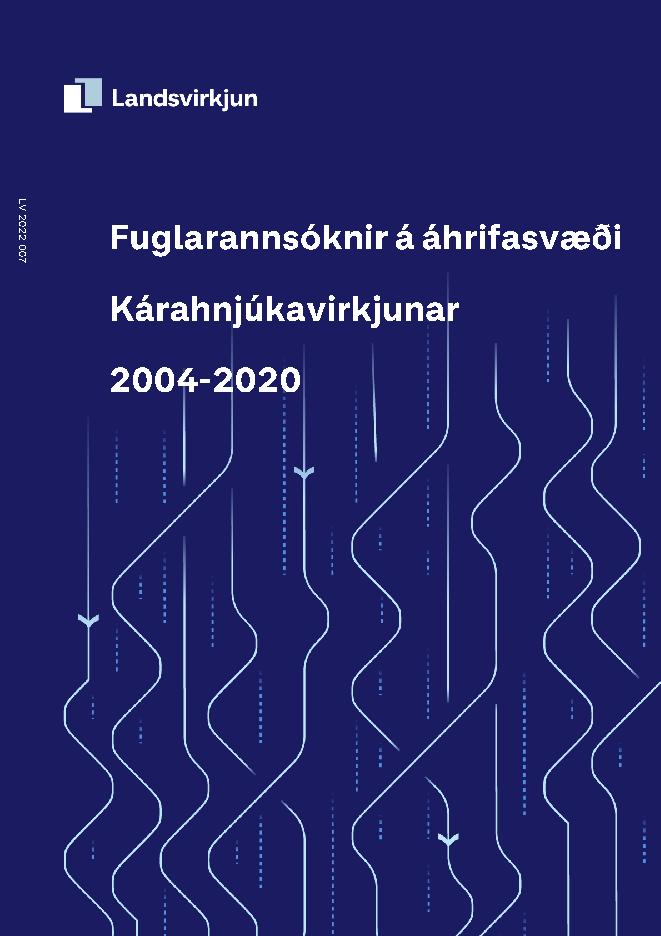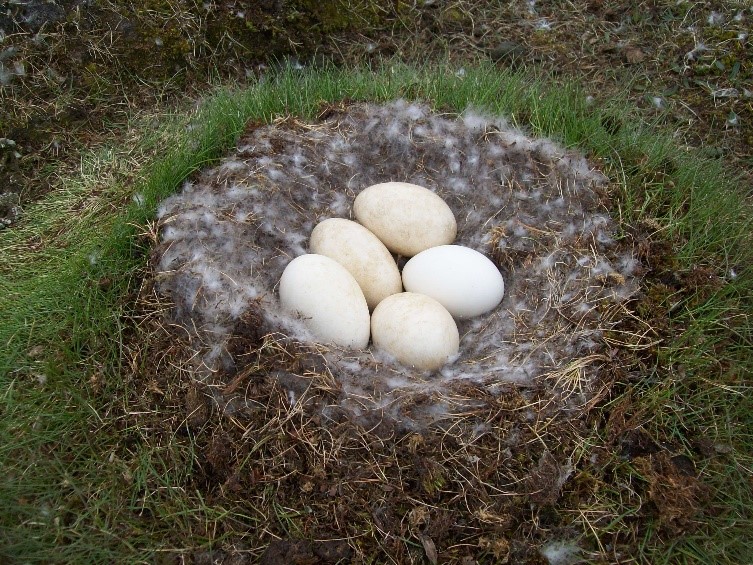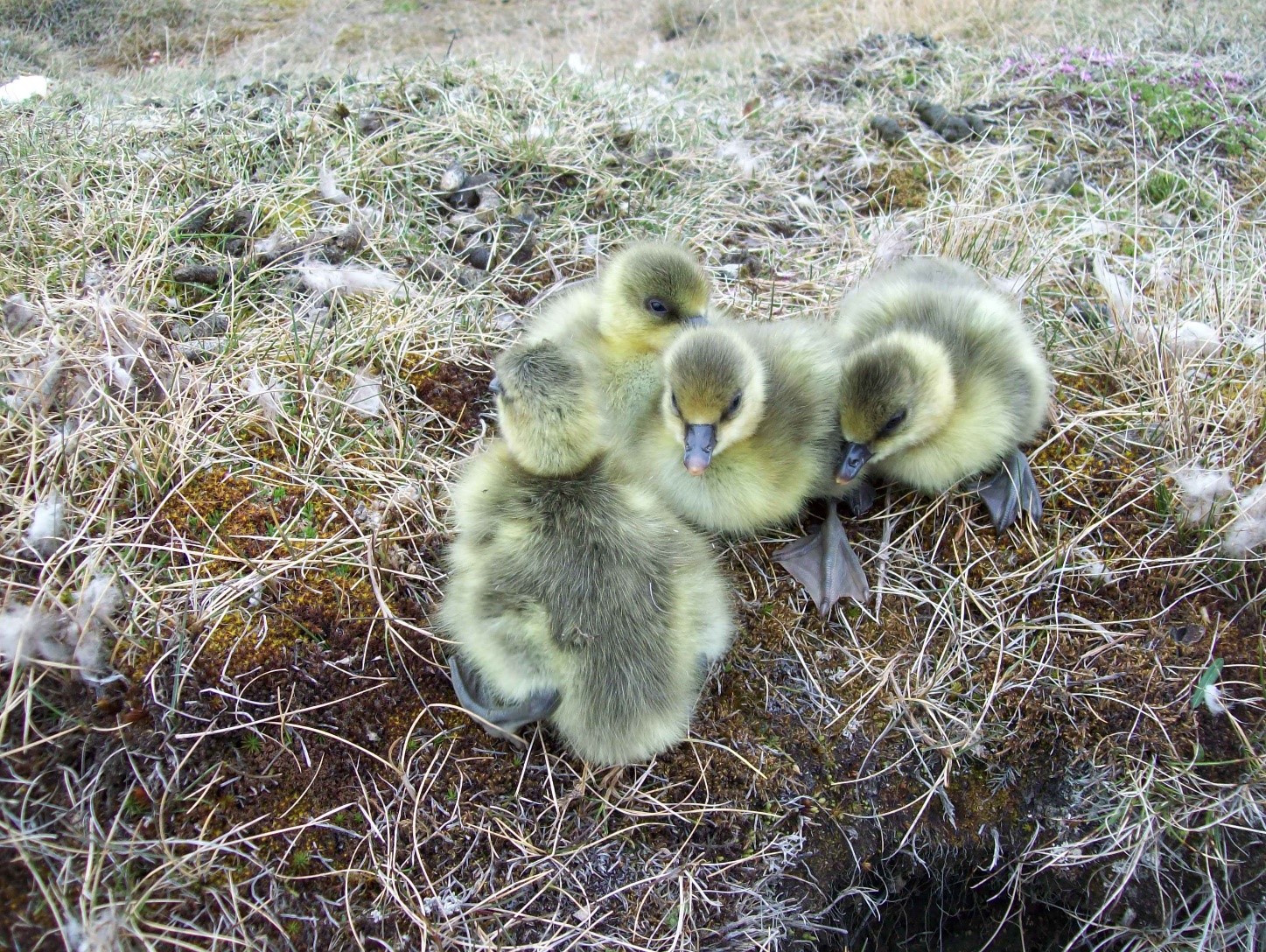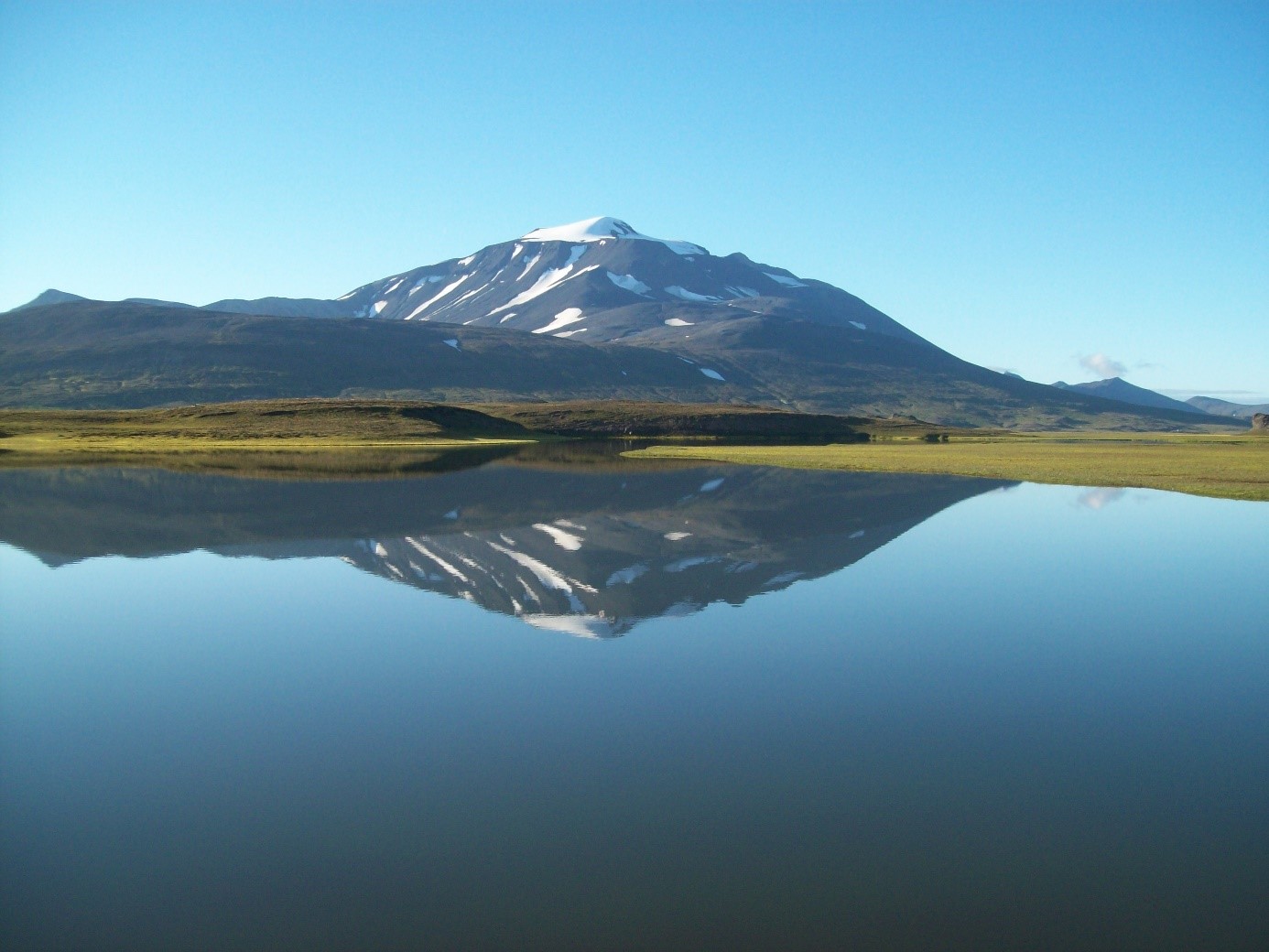Progress
The number of pink-footed geese in selected sites at the basins of Jökulsá á Dal and Jökulsá í Fljótsdal rivers.
The population of pink-footed geese has increased rapidly over the last decades, and this development has been pronounced in the Fljótsdalshérað and surrounding heaths. Hálslón reservoir did not cause a reduction in the number of geese despite decreased grazing area, and over 500 (531) nests disappeared (see table under Baseline). The number of nests has increased since 1981, both near Hálslón (Figures 1), by Jökulsá á Dal in Efra Jökuldalur and Hnefilsdalur (Figure 2) and Snæfells- and Brúaröræfum (Figure 3). This development indicates that the lack of nesting sites has hardly hindered the nesting of pink-footed geese.
According to counts of pink-footed geese in Vesturöræfi from 2008-2022, there have been significant fluctuations in the number of nests in the recent decade. The average density of nests per km² has been between 9-37 nests. The different densities seem mainly controlled by spring cold spells and heavy snow during spring. In 2011, the spring came late, with a cold period in the second half of May, causing a 60% decrease in the number of goose nests in Vesturöræfi. Bad weather conditions like these are known to be favorable to predators, causing even more harm. The pink-footed goose recovered in the next two years, and the number of nests increased following the development at Hálslón and Vesturöræfi before 2011. The springs of 2014-2016 were characterized by heavy snow, again causing a decrease in nests' numbers. This was followed again by increased nesting (Figure 1).
Pink-footed geese nests have been counted in the Kringilsárrani reserve west of Hálslón in 2000, 2008, and 2017 (Figure 3). Nests increased from 400 in 2000 to over 2000 in 2017, and the density increased from around 20 to 70 nests per km² (Figure 1).
Figure 1. Results of nest counts in the vicinity of Hálslón 1981-2022. The average density of nests per square kilometre in Kringilsárrana from 2000-2017 and Vesturöræfi from 2008-2023. Counts from Háls are from the years 1981-2007, but after 2007, the nesting area in Háls disappeared under Hálslón, and the geese moved up to the Vesturöræfa plateau. Numbers from 1981, 1987, and 2000 are based on information from Kristinn Haukur Skarphéðinsson and Skarphéðinn G. Þórisson 2001. The total number of nests that went under Hálslón was given, and the density shown here is calculated from that. It is variable how many sections were counted each year and how they are distributed within Vesturöræfi and Kringilsárrani. A minimal section was counted in Vesturöræfi due to weather conditions in 2014. No section was counted in 2020 and 2021 due to unfavorable weather conditions.
Nesting grounds steadily increased in Jökuldal and its side valleys, Hnefilsdal and Húsárdal, from 2000 until 2018, when it was last counted there (Figure 2). The most significant increase was between Steinshlaup and Merki, where 504 nests were counted in 2000, but in 2014, the number of nests had more than tripled to 1788. There was also a significant increase in the area in Hnefilsdal, where 407 nests were counted in 2000, but in 2018 they had become 1285. However, the relative most significant increase was in the area between Skjöldólfsstaðir (Gilsár) and Selland (Brúaráss), where one nest was found in 2001, but in 2015 there were 390. The smallest increase seems to have been in Húsárdal, where 304 nests were counted in 2010 but 326 in 2018 (Figure 2.)
Figure 2. The number of nesting grounds in Jökuldal and Hnefilsdal 1981-2018, as well as in Húsárdal in 2010, 2015, and 2018. In 2014, there were no counts within Þverá in Hnefilsdal. These areas have not been counted since 2018.
There has also been significant growth in the Snæfell and Brúaröræfi (Figure 3). For comparison, there were counts from these areas from the years 1981 and 1983. The increase differed depending on the region, and the number fluctuated depending on the year. Thus, there seemed to be a slight increase in Hafrahvammur since 1981, when 169 nests were found. 2016, there were 190 nests, but the number was 296 in 2008. Then, there was a slight decrease in the number of nests between counts in Laugavalladal and Sauðárdal from 2008, when there were 183 nests, to 2016, when there were 126 nests.
Figure 3. Number of nests in nesting areas on Snæfell and Brúaröræfi from 1981 to 2020: in Hafrahvammar, in Hrafnkelsdalur and its sub-valleys Glúmsstaðadalur and Þuríðardalur and Laugarvalladalur and Sauðárdalur. In 2018 and 2019, Hrafnkelsdalur was not counted; the counting took place in its sub-valleys. No counting was done in 2020 or 2021. In 2014, it was not counted within Þverá in Hnefilsdalur. Figures for 2005 are based on Kristinn Haukur Skarphéðinsson and Skarphéðinn G. Þórisson 2001.
Figure 4. Pink-footed goose nest. Photo from the East Iceland Nature Research Center
Figure 5. Pink-footed geese nestlings. Image from the East Iceland Nature Research Center.
The number of moulting geese in the Eyjabakkar area and by Hálslón Reservoir.
The number of moulting geese in Eyjabakki decreased from 1991, when there were a maximum of about 13.000 birds, to 2008, when there were only about 2.000 birds. From 2008, their number increased again and peaked at almost 9.700 birds in 2016, but decreased until 2020. 2021 the number rose again, and 8.600 birds were counted, but the number decreased slightly the following year (Figure 6).
Figure 6. The numbers of moulting geese in the Eyjabakki area from 1979-2022 according to aerial counts by Skarphéðins G. Þórissonar 1979-2004 and East Iceland Nature Research Center from 2005-2022. The year 2023 was not counted due to a plane crash.
Figure 7. Eyjabakkar area. Image from the East Iceland Nature Research Center.
Observation of the use of moulting geese at Hálslón, west of Snæfell, began in 2008. In 2009 and 2010, there were no counts, but from 2011 to 2022, they counted annually. The most significant number of moulting geese in Hálslón from 2008 to 2022 was the first year it was counted (2008), with about 2000 geese and a few younger ones. Most of the geese were on the East Coast and, therefore, most likely came from Vesturöræfi. After that, the number fluctuated considerably but decreased further in the lagoon, both east and west.
Figure 8. Moulting pink-footed geese in the Eyjabakkar area 2007-2022 and the proportion of year-old (12—to 14-month-old) geese in 2009-2011 and 2015-2019 and 2022. Blue bars indicate the years' ratios were not examined, and no count was made in 2020 and 2021.
The proportion of year-old pink-footed geese in the breeding groups indicates the breeding success in the previous year. This proportion has been documented in the Eyjabakkar area from 2009 to 2011, 2015 to 2019, and 2022 (Figure 9). The proportion of the year-old geese has been relatively stable during this period or, on average, around 29%, highest in 2011 (44%) and lowest in 2019 (21%).
Figure 9. The percentage of feathers of one-year-old heather geese in the Eyjabakka area out of all the feathers collected from 2009 to 2023, with some breaks.
Updated: March 15, 2024
Source: East Iceland Nature Research Center (2024).
Metrics, Targets and Monitoring Protocol
What is measured?
- Number of breeding birds in selected sites in the river basins of Jökulsá á Dal and Jökulsá í Fljótsdal valley. (Project effect: indirect).
- Number of moulting geese in Snæfellsöræfi (Project effect: indirect).
Monitoring Protocol
- Counting of nests (number of pink-footed goose pairs in selected nesting sites): Annual counts in areas near Hálslón reservoir and Vesturöræfi wilderness. For comparison countings will be performed alternately in different areas, that is in Hrafnkelsdalur valley and areas in the lower Jökuldalur valley.
- Countings of moulting pink-footed geese: Annual bird counting of moulting pink-footed geese will be continued annually in the Eyjabakkar and Hálslón areas, and with intervals in other areas of Snæfellsöræfi.
Targets/expectations
- The number of breeding birds will not decrease by more than 600 pairs.
- The number of geese in moulting in Snæfellsöræfi will not decrease from baseline information collected in 2005.
Changes of indicator
This indicator was originally number 24.1. It was then named Pink-footed Goose and can be found under that number in documents of the project from 2005 and 2006.
The indicator number has been changed twice.
| Year | Nr. | Indicator name |
|---|---|---|
| 2020 | 2.5.2 | Pink-Footed Goose |
| 2007 | 2.21 | Pink-Footed Goose |
Baseline
The number of pink-footed goose breeding pairs in East Iceland almost quadrupled in the period from 1980 to 2000. This increase has been similar proportionally to the total increase in the Icelandic-Greenlandic stock.
In 1981, 2,000 pairs were estimated to nest in the area, 4,000 pairs in 1988, and 7,300 pairs in the year 2000. These numbers account for roughly 15-20 percent of the breeding pairs of the Icelandic-Greenlandic stock. The Icelandic-Greenlandic stock accounts for 85 percent of pink-footed geese in the world.
In 2005, almost 50 percent of all breeding pairs in East Iceland (3,300 pairs) nested in 40 sites located in the river basins of Jökulsá á Dal river. The largest sites were in Kringilsárrani (300-400 pairs), along the river upstream of Sandfell mountain (i.e., the area that was inundated by Hálslón reservoir, 330 pairs), in Hafrahvammagljúfur gorge (206), between Hölkná river and Merki farm (435), by Hnefla river (407) and in Glúmsstaðadalur valley (293). The largest site at the river basin of Jökulsá í Fljótsdal is located between Kleif farm and Laugará river (96 pairs).
In some breeding sites in the river basin of Jökulsá á Dal, the number of nests had remained stable for 20 years before the dam was built or grown very slowly (by less than 3 percent per year). In other sites, however, the number had grown rapidly, even up to 10-15 percent per year. Overall, the breeding stock of the pink-footed goose in East Iceland has been growing at a similar rate as the Icelandic-Greenlandic stock that showed high growth rates from 1980 to 1995.
| Sites | # of breeding pairs | Nests that disappear |
|---|---|---|
| Sauðá river, Vesturöræfi wilderness | 96 | 66 |
| Kringilsárrani | 300 | 50 |
| Jokulsá river, upstream of Sandfell mountain | 330 | 330 |
| Sauðá river, Brúardölum valleys | 50 | 40 |
| Jökulsá river downstream of Eyjabakkar | 5 | 5 |
| Glúmsstaðadalur, valley | 193 | 40 |
| Total | 994 | 531 |
Updated: April 2, 2012
Source: East Iceland Nature Research Center
Rationale for Indicator Selection
The experience from monitoring the breeding population has until now shown constant increase and colonization of new areas. The monitoring has taken this development into account, to repeat some counts annually (areas in the vicinity of Hálslón reservoir) while other areas are monitored alternately.
The dispersal of sterile birds in the moult is far more complicated. Data exists from Eyjabakkar for several decades and occasional counts from other areas. With the emergence of the Hálslón reservoir, conditions for moulting geese emerged alongside the reservoir. Counting of geese around Hálslón reservoir has recently begun and is conducted concurrently with counting at Eyjabakkar area.
Updated: 2013
Original Rationale for Indicator Selection
The Kárahnjúkar project is believed to affect the pink-footed goose considerably.
The impact will be both temporary, due to construction activity, and long-term. Firstly, some breeding sites and grazing land were inundated by the Hálslón reservoir. Secondly, more traffic in the area during construction, and because of better access to the area, can disturb the birds.
In 2000, a total of 2,200 pairs of pink-footed geese nested within the impact area of the dam. Nesting sites for a total of 500 to 600 breeding pairs were inundated by Hálslón reservoir, which amounted to about one-third of all nests in Brúardalir valleys and Vesturöræfi wilderness (including tributary valleys of Hrafnkelsdalur valley). This corresponds to seven percent of breeding pairs in East Iceland and 1-2 percent of the total number of breeding pairs in the Icelandic-Greenlandic stock.
The land submerged to make the Hálslón reservoir is considered an internationally important breeding site for the pink-footed goose according to criteria in the Ramsar Convention and the International Bird Committee. Grazing land for the pink-footed goose has been interrupted, and increased traffic during and after construction has a negative effect on living conditions for geese in the area.
Neither Hálslón reservoir nor other smaller reservoirs of Kárahnjúkavirkjun power plant are likely to influence moulting sites for the pink-footed goose.
From phase I/II report on indicators and baseline from April 2005
Further reading

LV-2022/007 - Fuglarannsóknir á áhrifasvæði Kárahnjúkavirkjunar 2004-2020
Skýrslan segir frá fuglarannsóknum sem kveðið var á um í úrskurði ráðherra vegna byggingar Fljótsdalsstöðvar. Áhrif Kárahnjúkavirkjunar á fuglalíf eru ekki endilega augljós og aðgreinanleg frá öðrum áhrifum s.s. tíðarfari tengt náttúrulegum langtíma- og skammtímasveiflum, sem hafa ýmis afleidd áhrif á fuglalíf. Heiðagæsum hefur fjölgað á tímabilinu þrátt fyrir að hafa misst varpsvæði undir Hálslón.
You can view more material related to the indicator by clicking on the link above.
In 2021, a report was published detailing the results of research on birds in the area affected by the Kárahnjúkar hydropower plant in the period 2004-2020.
Halldór W. Stefánsson, Skarphéðinn G. Þórisson og Kristín Ágústsdóttir (2021). Fuglarannsóknir á áhrifasvæði Kárahnjúkavirkjunar 2004-2020. LV -2022-007 (NA-210214).
Kristinn Haukur Skarphéðinsson og Skarphéðinn G. Þórisson (2001). Áhrif Kárahnjúkavirkjunar á heiðagæsir. Náttúrufræðistofnun Íslands, NÍ-01003.



